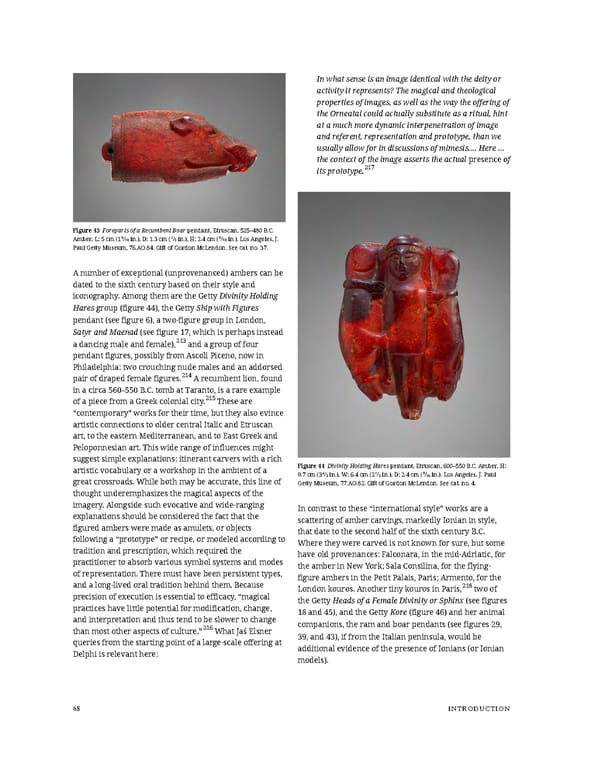In what sense is an image identical with the deity or activity it represents? The magical and theological properties of images, as well as the way the offering of the Orneatai could actually substitute as a ritual, hint at a much more dynamic interpenetration of image and referent, representation and prototype, than we usually allow for in discussions of mimesis.… Here … the context of the image asserts the actual presence of its prototype.217 Figure 43 Foreparts of a Recumbent Boar pendant, Etruscan, 525–480 B.C. Amber, L: 5 cm (19⁄10 in.), D: 1.3 cm (1⁄2 in.), H: 2.4 cm (9⁄10 in.). Los Angeles, J. Paul Getty Museum, 76.AO.84. Gift of Gordon McLendon. See cat. no. 37. A number of exceptional (unprovenanced) ambers can be dated to the sixth century based on their style and iconography. Among them are the Getty Divinity Holding Haresgroup (figure 44), the Getty Ship with Figures pendant (see figure 6), a two-figure group in London, Satyr and Maenad(seefigure 17, which is perhaps instead a dancing male and female),213 and a group of four pendant figures, possibly from Ascoli Piceno, now in Philadelphia: two crouching nude males and an addorsed pair of draped female figures.214 A recumbent lion, found in a circa 560–550 B.C. tomb at Taranto, is a rare example of a piece from a Greek colonial city.215 These are “contemporary” works for their time, but they also evince artistic connections to older central Italic and Etruscan art, to the eastern Mediterranean, and to East Greek and Peloponnesian art. This wide range of influences might suggest simple explanations: itinerant carvers with a rich artistic vocabulary or a workshop in the ambient of a Figure 44 Divinity Holding Hares pendant, Etruscan, 600–550 B.C. Amber, H: 9.7 cm (34⁄5 in.), W: 6.4 cm (21⁄2 in.), D: 2.4 cm (9⁄10 in.). Los Angeles, J. Paul great crossroads. While both may be accurate, this line of Getty Museum, 77.AO.82. Gift of Gordon McLendon. See cat. no. 4. thought underemphasizes the magical aspects of the imagery. Alongside such evocative and wide-ranging In contrast to these “international style” works are a explanations should be considered the fact that the scattering of amber carvings, markedly Ionian in style, figured ambers were made as amulets, or objects that date to the second half of the sixth century B.C. following a “prototype” or recipe, or modeled according to Where they were carved is not known for sure, but some tradition and prescription, which required the have old provenances: Falconara, in the mid-Adriatic, for practitioner to absorb various symbol systems and modes the amber in New York; Sala Consilina, for the flying- of representation. There must have been persistent types, figure ambers in the Petit Palais, Paris; Armento, for the and a long-lived oral tradition behind them. Because London kouros. Another tiny kouros in Paris,218 two of precision of execution is essential to efficacy, “magical the Getty Heads of a Female Divinity or Sphinx (see figures practices have little potential for modification, change, 18and45), and the Getty Kore (figure 46) and her animal and interpretation and thus tend to be slower to change companions, the ram and boar pendants (see figures 29, than most other aspects of culture.”216 What Jaś Elsner queries from the starting point of a large-scale offering at 39, and 43), if from the Italian peninsula, would be Delphi is relevant here: additional evidence of the presence of Ionians (or Ionian models). 68 INTRODUCTION
 Ancient Carved Ambers in the J. Paul Getty Museum Page 77 Page 79
Ancient Carved Ambers in the J. Paul Getty Museum Page 77 Page 79